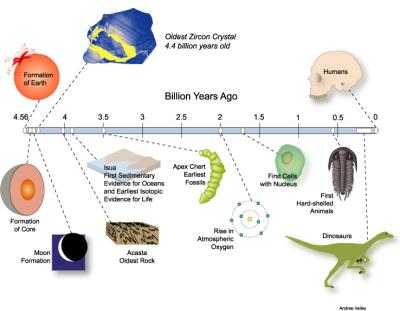Immer noch bekommt man hier und da zu lesen, der fünfte Kontinent sei der jüngste von allen. Das (kaum wirklich vorstellbar) hohe Alter des Finke Rivers zeigt aber schon, wie verfehlt solche Äußerungen sind. Im Gegenteil gehört der kontinentale Kern Australiens zu den ältesten Gesteinsschichten auf der Oberfläche der Erde. Der allgegenwärtige rote Sand ist nichts anderes als der Rest von im Lauf der Jahrmillionen zu Staub zermahlener Gebirge.

Lange war man der Meinung, die ältesten auffindbaren Gesteine der Erde lägen im Gebiet um die Hudson Bay in Kanada. Der Kanadische Schild enthält mehrere Kerne von ehemaligen Urkontinenten (Kratone), die viel älter sind als die heutigen Kontinentalschollen und seit der Erdfrühzeit, dem Präkambrium, keine Umformungen mehr erfahren haben. In Québec hat man metamorph umgewandelten Basalt, sogenannten Amphibolit, gefunden, der bis zu 4,28 Milliarden Jahre alt ist. Da fehlen nur noch schlappe 280 Millionen Jahre bis zur angenommenen Entstehung der Erde vor 4,56 Milliarden Jahren.
Und doch sind die Amphibolite aus dem Nuvvuagittuq-Grünsteingürtel heute nicht mehr die ältesten bekannten Gesteine. Im Januar 2001 meldete die Zeitschrift Nature, von Geologen seien detritische Zirkone gefunden worden, die 4,404 Milliarden alt seien. Und wo wurden sie gefunden? In Westaustralien. Die Jack Hills sind nichts anderes als durch Erosion jüngerer Erdschichten (hier Gneis und Granit) wieder freigelegtes Kraton-Urgestein aus präkambrischen Zeiten.
“The hills are within the Narryer Gneiss Terrane of the Yilgarn Craton and are composed of metamorphosed basalts, ultramafic rocks (igneous rocks that contain low amounts of quartz and feldspars), cherts, banded iron formation and rocks that are composed of weathered material sourced from older rocks known as clastic meta-sediments. Within these metamorphosed sediments, geologists have found crystals of the mineral zircon that are older than any other known material on Earth.”
(Dieses und die folgenden engl. Zitate sind einer Veröffentlichung des australischen Umweltministeriums entnommen)

Zirkon ist ein ziemlich häufiges Mineral von so großer Härte, daß es manchmal Diamanten ersetzt und größere Stücke als Edelsteine gehandelt werden. Durch seine Uranisotope trägt es zur natürlichen Radioaktivität bei, außerdem erlauben sie durch ihre bekannten Verfallszeiten sehr genaue Datierungen. Zirkone selbst aber sind “gegenüber geologischen Einflüssen wie Verwitterung und selbst hochgradiger Gesteinsmetamorphose äußerst resistent und können solche Ereignisse in ihrer Isotopenzusammensetzung ‘speichern’“ (Wikipedia).
“Zircon is unique in that it is one of the only minerals that over a long period of time, can preserve chemical information that indicates what conditions were like when the crystals were originally formed.”
Nun haben aber die Zirkone von Jack Hill aus der Formationszeit der Erde, dem Hadaikum, nicht allein Urannuklide eingelagert, sondern auch bestimmte Sauerstoffisotope, die nur in Anwesenheit von Wasser entstehen.
“The chemical analysis of the Jack Hills zircon crystals has indicated that the Earth had surface water and a hydrosphere much earlier than previously thought. Oxygen isotopes found within zircon crystals are a sensitive, temperature-dependant indicator of liquid and solid interactions in the Earth's crust. Zircon crystals with high oxygen 18 to oxygen 16 isotope ratios such as some of those found at Jack Hills, can only be formed if crustal material interact with surface or near surface water at low temperatures. That the zircon crystals formed within a continental (surface) crust implies that the Earth had at least a partially stabilised terrestrial surface at this early stage of its development... Previous to the discovery of the age and geochemical properties of the ancient Jack Hills zircons, it was generally thought it would not have been possible for the Earth to have a terrestrial surface during the early stages of its development due to the constant bombardment of the earth by meteoritic material in the solar system.
The discovery that stable, low temperature conditions may have existed for periods of time at such an early stage in the Earth's development also has wider implications for the study of early life. As low temperatures and the presence of liquid water are the requirements for life, the discovery of both in the geochemistry of the Jack Hills zircon crystal has led scientists to suggest the possibility of life occurring on Earth at least 400 my earlier than was previously thought possible.”
... link (0 Kommentare) ... comment



